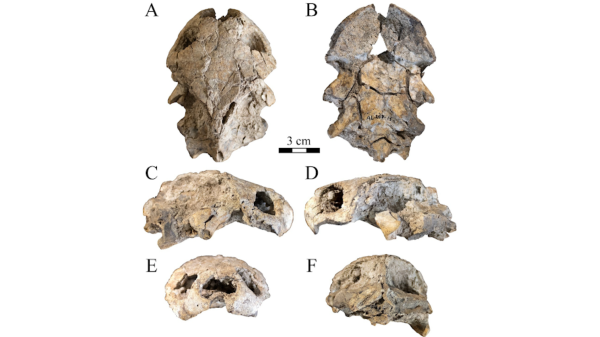Breakthrough copper alloy achieves unprecedented high-temperature performance

An atomic-scale image of a groundbreaking high-temperature copper alloy with exceptional thermal stability and mechanical strength. The orange-colored features represent copper matrix atoms, the yellow-colored features represent tantalum atoms and the blue features represent lithium atoms. Photo courtesy of Kiran Solanki
A team of researchers from Arizona State University, the U.S. Army Research Laboratory, Lehigh University and Louisiana State University has developed a groundbreaking high-temperature copper alloy with exceptional thermal stability and mechanical strength.
The research team’s findings on the new copper alloy, published in the prestigious journal Science, introduce a novel bulk Cu-3-Ta-0.5Li nanocrystalline alloy that exhibits remarkable resistance to coarsening and creep deformation, even at temperatures near its melting point.
“Our alloy design approach mimics the strengthening mechanisms found in Ni-based superalloys,” said Kiran Solanki, a professor at the Ira A. Fulton Schools of Engineering in the School for Engineering of Matter, Transport and Energy and a co-author of the study.
Currently, nickel-based superalloys, known for their exceptional strength, corrosion resistance and high-temperature stability, are the primary material used in applications where these properties are critical, such as aerospace components, gas turbine engines and chemical processing equipment.
New materials are especially needed throughout the aerospace and defense industries — think of the strength, durability and heat resistance needed for high-speed flight or deploy weaponry. This spurs the research community to continue to push the boundaries of high-impact technologies.
“We have to critically think about what we can do to solve engineering problem in a more outside-the-box way,” Solanki said. “At the end of the day, I'm more curious about what I don't know.”
Solanki's main research interests investigate the structure and property relationships of advanced materials across multiple length scales. His goal is to manufacture advanced, multifunctional materials for extreme applications including radiation, high rate, fatigue and prevention of slow deformation under mechanical stresses, or creep.
“When we look inside our body, we try to look for fingerprints of cell mutation for cancer,” Solanki said. “Similarly, structural materials have a unique fingerprint when they are subjected to any event like radiation or heat. They will leave behind a fingerprint which causes them to fail or not to perform the way they should perform.”
The newly engineered alloy owes its superior properties to a unique nanoscale structure featuring precisely ordered copper lithium precipitates surrounded by a tantalum-rich atomic bilayer. The addition of precisely half a percent of lithium — no more, no less — to the previously immiscible Cu-Ta system alters the precipitate morphology. It changes the sphere-like precipitate in Cu-Ta system into forming stable cuboidal structures that significantly enhance thermal and mechanical performance.
“And in this case, having a copper lithium precipitate with a stable bilayer of Ta is when we can alter high temperature fingerprint for failure,” Solanki said. “By manipulating fingerprints, we have developed a copper alloy that maintains its strength and structural integrity even after prolonged exposure to high temperatures.”
Key findings from the copper superalloy research include:
- Enhanced thermal stability: The Cu-3Ta-0.5Li alloy remains stable at 800 degrees C for over 10,000 hours, with minimal loss in yield strength.
- High-temperature strength: The alloy outperforms existing commercial copper alloys, achieving a yield strength of 1120 MPa at room temperature.
- Superior creep resistance: Cu-Ta-Li exhibits significantly lower creep deformation compared to conventional Cu-Ta alloys, making it ideal for high-stress, high-temperature environments.
The discovery opens new avenues for the development of next-generation copper alloys for applications in aerospace, energy and defense industries. Potential uses include heat exchangers, high-performance electrical components, weaponry and structural materials requiring durability in extreme conditions.
“This research not only advances our understanding of alloy design but also paves the way for materials that can withstand extreme environments,” said Kris Darling, another Army Research Laboratory co-author of the study. “The manipulation of fingerprints through nanostructuring in alloy could revolutionize the way we approach high-temperature material development.”
The study, titled "A High-Temperature Nanostructured Cu-Ta-Li Alloy with Complexion-Stabilized Precipitates," was supported by the U.S. Army Research Laboratory, the National Science Foundation and Lehigh University’s Nano-Human Interfaces Initiative.
More Science and technology

New research by ASU paleoanthropologists: 2 ancient human ancestors were neighbors
In 2009, scientists found eight bones from the foot of an ancient human ancestor within layers of million-year-old sediment in the Afar Rift in Ethiopia. The team, led by Arizona State University…

When facts aren’t enough
In the age of viral headlines and endless scrolling, misinformation travels faster than the truth. Even careful readers can be swayed by stories that sound factual but twist logic in subtle ways that…

Scientists discover new turtle that lived alongside 'Lucy' species
Shell pieces and a rare skull of a 3-million-year-old freshwater turtle are providing scientists at Arizona State University with new insight into what the environment was like when Australopithecus…


